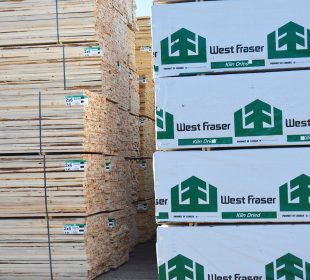Canfor Corporation generated strong financial results in 2018 with reported operating income of $608.6 million, the highest operating earnings in over 10 years, and up $51.2 million, or 9 per cent, from 2017. Reported annual results include record-high pulp and paper segment earnings and solid lumber segment operating income. The latter was achieved despite major challenges presented by significant log supply constraints and log cost increases in British Columbia, severe transportation issues in the first half of the year, extreme weather across North America and one of the worst forest fire seasons in B.C., as well as significant market volatility during the year.
For the fourth quarter of 2018, the company reported an operating loss of $79.1 million, down $280.9 million from reported operating income of $201.8 million for the third quarter of 2018, with the decline in earnings reflecting lower operating income for both the lumber and pulp and paper segments. Reported results for the fourth quarter of 2018 include a net duty expense of $39.9 million, at a current cumulative effective countervailing duty (CVD) and anti-dumping duty (ADD) rate of 16.14 per cent, compared to $42.6 million reported in the third quarter of 2018. Reported results in the fourth quarter of 2018 also include a $36.7 million inventory valuation adjustment, representing the excess of the carrying cost of year-end lumber and log inventory over net realizable value. After adjusting for the aforementioned items, the company’s operating loss was $2.5 million for the fourth quarter of 2018, down $246.9 million from similarly adjusted operating income in the third quarter of 2018.
Adjusted lumber segment results reflected substantially lower Western Spruce/Pine/Fir (Western SPF) and Southern Yellow Pine (SYP) benchmark lumber prices, lower production and shipments, particularly in B.C., and significantly higher unit log costs in Western Canada. A combination of log supply constraints, log costs and market conditions resulted in Canfor curtailing production at the company’s B.C. lumber operations by approximately 100 million board feet in the fourth quarter, with a further estimated reduction of approximately 95 million board feet in the first quarter of 2019.
North American demand
North American lumber consumption was down slightly in the fourth quarter of 2018, in part reflecting waning demand as the quarter progressed. U.S. housing starts, on a seasonally adjusted basis, averaged 1,237,000 units (as at November 2018), in line with the previous quarter but down slightly from the fourth quarter of 2017. Single-family starts were down 4 per cent, while multi-family starts were up 8 per cent compared to the third quarter of 2018. Demand in the repair and remodelling sector continued to be very strong through the fourth quarter of 2018. In Canada, housing starts remained near historical highs, averaging 217,000 units on a seasonally adjusted basis, up 10 per cent from the previous quarter and down 5 per cent from the same period in 2017. Offshore lumber consumption remained solid, with shipments to China increasing in the quarter.
The slowing North American demand coupled with an excess of supply placed significant downward pressure on prices through the fourth quarter; the average benchmark North American Random Lengths Western SPF 2×4 #2&Btr price was down U.S.$155 per Mfbm, or 32 per cent, from the previous quarter, at U.S.$327 per Mfbm, with similar decreases also seen across most Western SPF wider-width dimensions. As a result, Western SPF lumber unit sales realizations were also significantly down quarter-over-quarter, as the sharp declines in benchmark Western SPF lumber prices more than offset the 1 cent, or 1 per cent, weaker Canadian dollar and a higher-value sales mix. SYP lumber unit sales realizations were also materially lower than the prior quarter reflecting increased available supply in the U.S. South region, a 6 per cent decrease in the SYP East 2×4 #2 price, and more pronounced seasonal price declines in wider SYP dimensions.
Canfor's total lumber shipments, at 1.11 billion board feet, were 14 per cent lower than the previous quarter, largely due to announced curtailments resulting in lower volumes available for sale, with a higher proportion of volumes sold offshore.
Canfor's total lumber production, at 1.13 billion board feet, was down 12 per cent from the previous quarter reflecting the impacts of the aforementioned temporary production curtailments at the company’s Western Canada operations, reduced shifts and, to a lesser extent, additional statutory holidays in the current quarter. In addition, inclement weather in the U.S. South impacted log deliveries and log profile, both of which contributed to lower productivity in the current quarter.
Canfor's lumber unit manufacturing costs in the fourth quarter of 2018 were moderately higher than the previous quarter, largely reflecting the effects of timing on market-based stumpage increases, log supply and profile shortages, combined with reduced sawmill productivity and production, and to a lesser extent, seasonally higher energy costs. Log costs in the U.S. South remained in line with the previous quarter.
Investments
The company maintained its strong balance sheet position in 2018, as it continued to apply a disciplined approach to cash allocation, while retaining a focus on internal investment and growth. Solid progress continued to be made on its previously announced U.S.$125 million organic growth initiative in the U.S. South and included the completion of various capital projects at the company’s Moultrie, Fulton and Urbana sawmills. Recognizing challenging market conditions and inflationary construction cost pressures the company has decided to defer its decision on the construction of a greenfield sawmill until at least the end of 2019.
On the acquisition front, the company entered into agreements to purchase Elliott and VIDA. Following the anticipated completion of these acquisitions in the first half of 2019, Canfor’s lumber production capacity will increase to approximately 7.2 billion board feet, which includes the Company’s SYP lumber capacity growing to approximately 2.0 billion board feet as a result of the Elliott acquisition and organic growth in the U.S. South.
Commenting on the company’s fourth quarter results, Canfor’s president and CEO, Don Kayne, said, “In our lumber business, the fourth quarter was challenging in Western Canada in terms of market conditions, log costs, and log supply constraints, which led to the difficult decision to temporarily curtail B.C. operations. We are encouraged by the recent overall market activity.”
Forecast
Looking further ahead, the U.S. housing market is currently forecast to show a modest recovery through 2019, while the repair and remodelling sector in the U.S. is projected to record solid growth. North American lumber prices are anticipated to improve through the first quarter of 2019 primarily reflecting low inventories in the supply chain as a result of production curtailments and seasonally stronger demand during the traditionally busy spring building season. For the company’s key offshore lumber markets, demand is anticipated to remain solid through the first quarter of 2019. Prices in Europe are projected to be more stable reflecting solid demand in that region. Results through 2019 are anticipated to be impacted by continued log cost pressure in Western Canada as a result of ongoing log supply constraints.

















